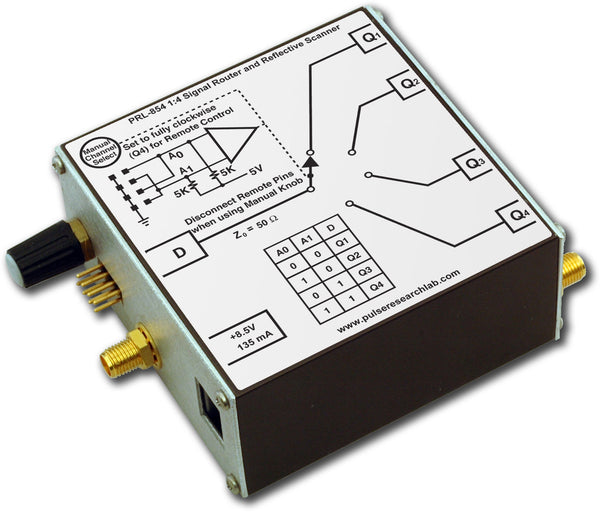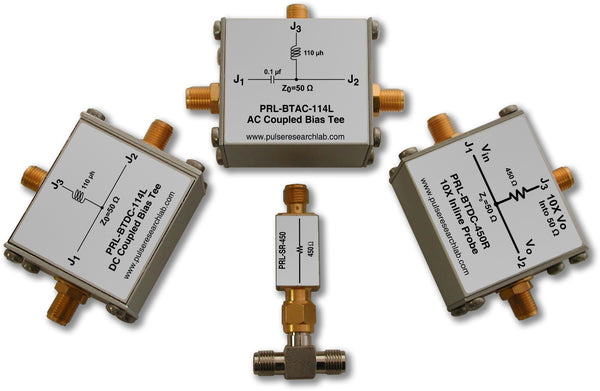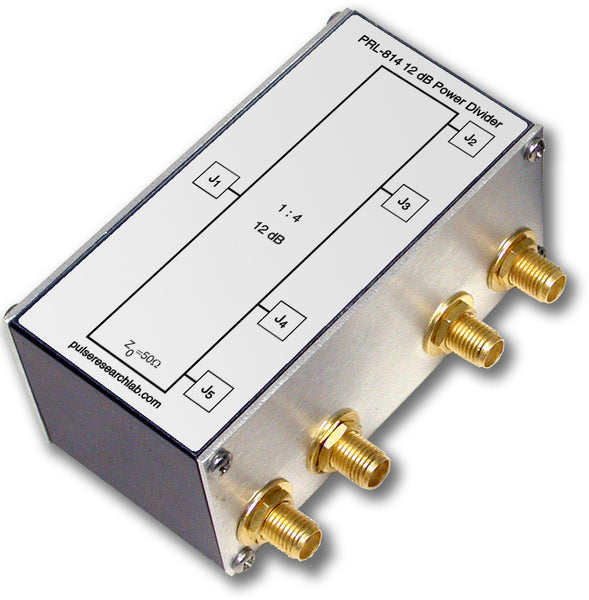Applications:
|
|
Features:
|
|
DescriptionThe PRL-426 is a series of NECL-, PECL-, LVPECL- or TTL-to-LVDS Logic Level Translators:
The PRL-426LP can receive either single-ended or differential input signals, selected by a switch. The differential outputs are 50 Ω back-terminated and are designed for driving floating 100 Ω loads, normally the configuration used in LVDS input circuits. The output swing is typically 600 mV with a common mode voltage of 1.2 V. The PRL-426LPTR, has Triax output connectors instead of the SMA connectors. These high speed translators facilitate testing of high speed digital communications circuits where conversion of LVPECL clock and data signals to LVDS level signals is often required. The PRL-426LP is designed to interface with +3.3 V or +3.0 V LVPECL circuits. In the differential input mode, both inputs D and D of the PRL-426LP are terminated into 50 Ω/+1.3 V. In this mode, either one or both inputs can accept AC coupled signals as well. In the single input mode, signals should be connected to the D inputs only. The D inputs are switched internally to VBB, nominally +2.0 V for LVPECL, and termination resistors RT for the D input channels are changed to 62 Ω. Each unit is supplied with a ±8.5 V/1.8 A AC/DC Adaptor and housed in a 1.3 x 2.9 x 3.9-in. extruded aluminum enclosure. Available accessories include voltage distribution modules for mounting multiple units. |
 Fig. 1: PRL-426LP Dual Ch. LVPECL to LVDS Translator, SMA Outputs
Fig. 1: PRL-426LP Dual Ch. LVPECL to LVDS Translator, SMA Outputs(0° C ≤ TA ≤ 35° C)*
| Symbol | Parameter | PRL-426LP | UNIT | ||
|---|---|---|---|---|---|
| Min | Typ | Max | |||
| Rin | Input Resistance | 49.5 | 50 | 50.5 | Ω |
| Rout | Output Resistance | 49.5 | 50 | 50.5 | Ω |
| VTT | "D" Input Termination Voltage (fixed) | 1.18 | 1.30 |
1.43 |
V |
| VT1 | "D" Input Termination Voltage (fixed) | 1.18 | 1.30 | 1.43 | V |
| VT2 | "D" Input Termination Voltage (variable) | 1.8 | 2.0 |
2.2 |
V |
| VOL | Output Low Level | 0.9 | V | ||
| VOH | Output High Level | 1.5 | V | ||
| VCMV | Common Mode Voltage1 | 1.2 | V | ||
| IDC1 | DC Input Current (+8.5 V) | mA | |||
| IDC2 | DC Input Current (-8.5 V) | mA | |||
| VDC1 | DC Input Voltage (+8.5 V) | 7.5 | 8.5 | 12.0 | V |
| VDC2 | DC Input Voltage (-8.5 V) | -12.0 | -8.2 | -7.5 | V |
| VAC1 | AC/DC Adapter Input Voltage (120 VAC) | 103 | 115 | 127 | V |
| VAC2 | AC/DC Adapter Input Voltage (220 VAC) | 206 | 230 | 254 | V |
| tPLH | Propagation Delay to output ↑ | 2 | ns | ||
| tPHL | Propagation Delay to output ↓ | 2 | ns | ||
| tr/tf | Rise/Fall Times2 (10%-90%) | 1 | 1.25 | ns | |
| tSKEW | Skew between any two outputs | 200 | 500 | ps | |
| fmax | Maximum Clock Frequency | 500 | 625 | MHz | |
| Size | 1.3 x 2.9 x 3.9 | in. | |||
| Weight | 7 | Oz | |||
Notes:
(1) VCMV = (VOH-VOL)/2
(2) Rise and Fall times are measured with SMA output connector units only and with ground-referenced 50 Ω loads.
(3) fmax is measured using a PRL-425N with the corresponding input connectors as the receiver. The NECL outputs of the PRL-425N are measured.
Units with the Trompeter CBBJR79 Triax ouput connectors are tested using the PRL-425NTR, Universal Differential Receiver (Triax) with Differential NECL outputs, and the Trompeter PCGOW10PCG-36 shielded twisted pair cables.
All PRL products with Triax connectors use Trompeter P/N CBBJR79, Right Angle Circuit Board Bulkhead Jack, 3-lug (Numbered page 10, document page 11 of 142). Any Trompeter 70-series Triax Cable Plug with 3 lugs (e.g. PL75-9, 3-lug) will mate with CBBJR79.
While we believe these models to be accurate, no representations are made as to accuracy or suitability for any application:
PRL-426LP:






